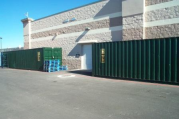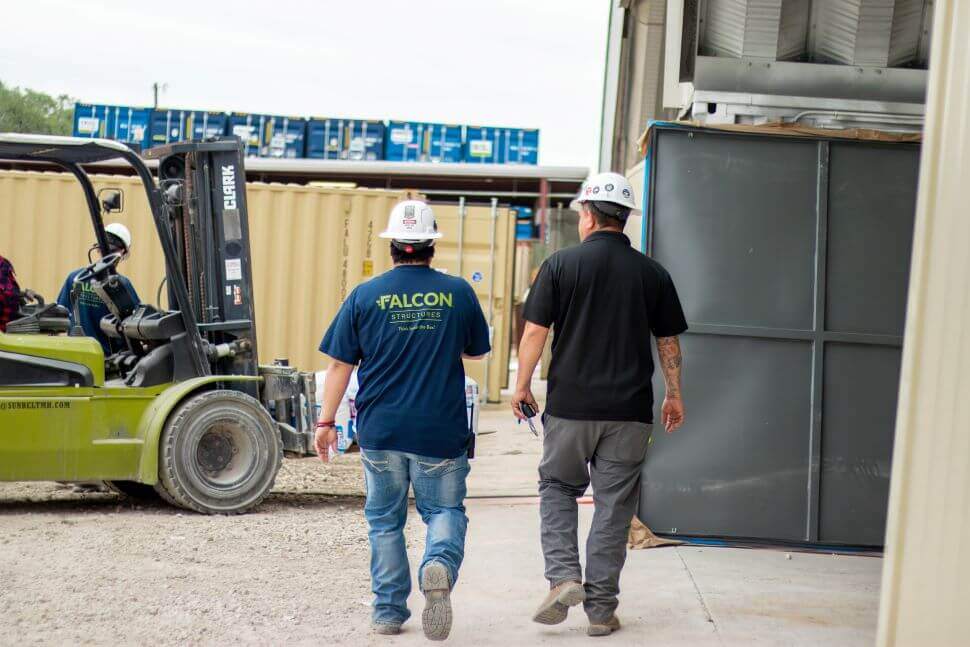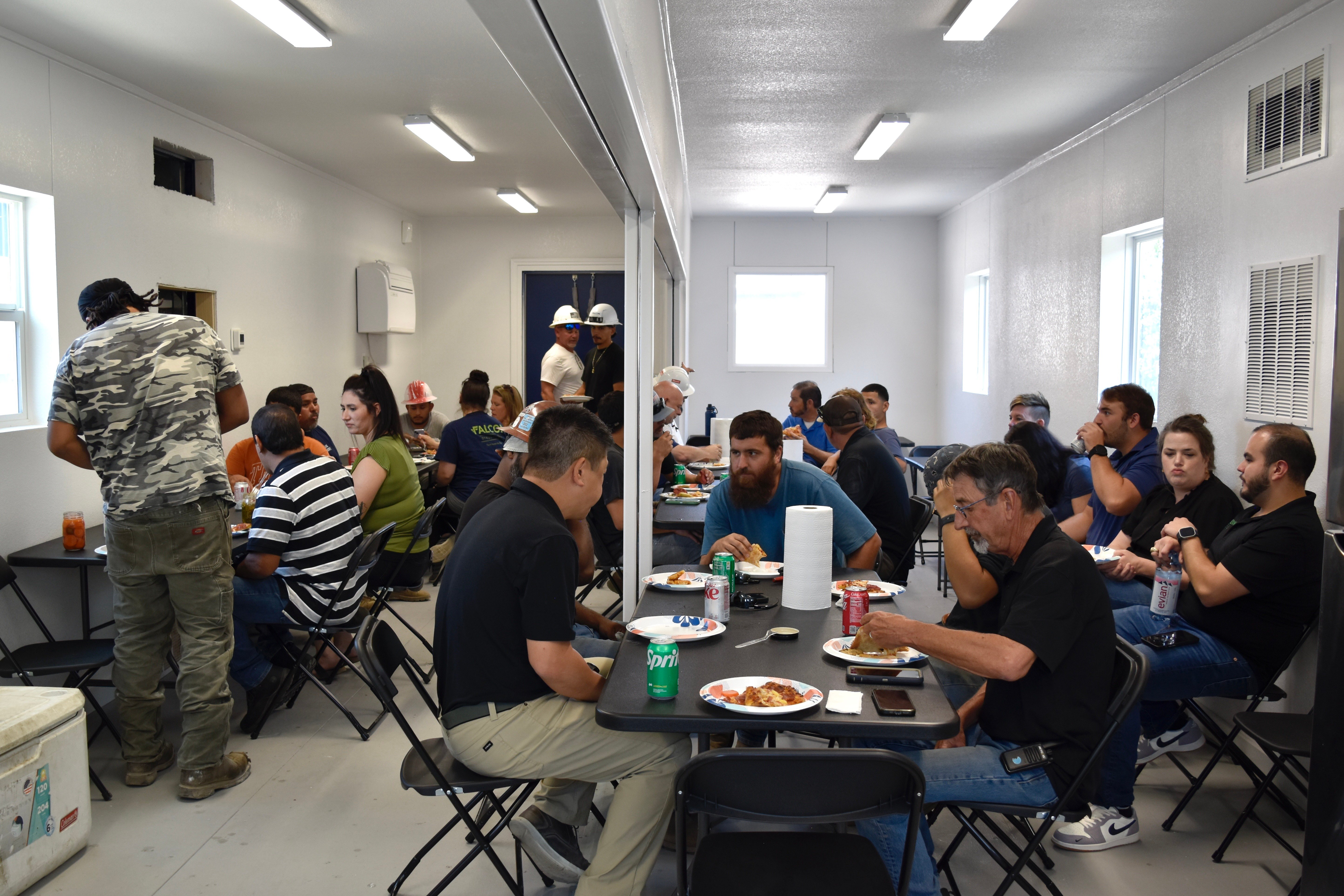Q&A with a Construction PM: Swapping Trailers for Container Offices
 Becca Hubert | Aug 6, 2025
Becca Hubert | Aug 6, 2025

When Jordan Foster Construction needed site offices at their El Paso Airport, Project Manager Dan Robillard took a different approach: ditch the mobile office trailers and try something new. We caught up with Dan to learn why he opted for container-based offices, how they’re performing on the jobsite, and what advice he’d give to other construction professionals weighing their options.
This interview has been edited for clarity and length.
Q: What’s your role at Jordan Foster Construction?
Dan: I’m the project manager—or one of them—at Jordan Foster, specifically for the El Paso Airport project. I’m actually sitting inside one of our containers right now, which are set up right in the middle of the airport field next to the fire department.
Q: What led you to explore container-based offices instead of traditional mobile trailers?
Dan: There were a couple of things. For one, the cost of renting office trailers has gotten out of hand. It got to the point where it just wasn’t productive to keep renting.
So we started buying office trailers. At the same time, our safety department was looking at building a small classroom and considering using converted shipping containers. That’s how I first heard about Falcon. I started comparing the benefits of containers versus trailers—and while there are some trade-offs, it made a lot of sense.
Q: What stood out to you about containers compared to mobile trailers?
Dan: They’re easier to move. A 20-foot container is pretty simple to transport, especially on smaller sites, and we don’t need permits like we do for mobile homes. Most of our jobs have loaders on-site, so we can move them around ourselves. Plus, once we own it, we can kind of do whatever we want to it.
Longevity was also a factor. Mobile trailers tend to get rickety with frequent relocation. They rack, the walls crack, and the siding curves. Containers are just structurally stronger. And they sit at ground level, which is great—we don’t need to haul steps around or build stairs.
Q: How are you using the containers on this project?
Dan: We’ve got two 20-footers and one 40-footer. They’re arranged with the two 20s facing each other and the 40 on the end, kind of like a “U.” This setup works well for offices, admin work, and small meetings. We’ve also got storage space for survey equipment and PPE.
This is also our storage yard, so workers come in and out throughout the day, especially to charge equipment or cool off. We’re out in the desert, so I installed sunshades and even added a solar setup with Unistrut to power cameras and create a shaded break area. It gets hot—like 100°F+ for six or seven weeks straight—so we buy pallets of water and make sure there’s a place to cool off.
Q: How does the comfort level compare to a mobile trailer?
Dan: Honestly, it’s very comfortable. I probably spend two to three days a week out here. The insulation has been great—especially the spray foam under the container. We’re out here in the high desert. One day before the containers were hooked up to power, the inside only shifted 10° despite a 50° swing in temperature. That tells me it’s holding temperature really well.
Q: What do you like most about using containers? Any drawbacks?
Dan: I really like how sturdy they are and how you can reconfigure them depending on your space needs. Maybe it’s the kid in me who liked Legos—but you can mix and match containers in a way you can’t with trailers. I’ve even joked about stacking another one to make a porch.
The only real drawback is width. Trailers are 10 feet wide, so you have a little more room for meetings. I’ve had six or eight people in here at once—it works, but it’s tight. Still, that’s just the nature of the beast. If I were setting up a permanent site, I might consider a double-wide, but for jobs that move, single units are better.
Q: What was the delivery process like?
Dan: Delivery and communication were great. We had a bit of a weird timeline with project delays, but Falcon was patient and worked with us. Everything showed up when expected, and we had what we needed to get set up.
Q: How was your experience working with Falcon?
Dan: It was great. Very easy. Communication was fantastic, and working with Michael was a big part of that. I probably ran him through the ringer a bit with emails and small customizations, but he was always helpful and responsive. We even made some small changes to the layout, like adding a divider wall to create a little separation between our project assistant and superintendent.
Q: Do you feel like the container offices were a good investment?
Dan: Yeah, I do. We probably spent more upfront compared to buying a trailer locally, but in the long run, it’ll save us in maintenance, mobility, and not having to deal with a lease. I didn’t want to go back to trailers because of bad experiences with support and being nickel-and-dimed when returning them. Containers just made more sense.
Q: What would you have done if you hadn’t found Falcon?
Dan: We probably would’ve gone with a trailer. I’d even looked at renting from someone in Dallas, but the delivery cost wiped out any savings. This just ended up being the right option, especially for how long we’re going to be out here.
Thank you to Dan Robillard for sharing his time and insight. This perspective offers a valuable look into the day-to-day decisions project managers face in a demanding industry: balancing cost, durability, and worker comfort on dynamic job sites. We’re proud to play a small part in helping teams like Dan’s create reliable, comfortable environments that help them do their best work.
Want more real-world takes on modular innovation and smart jobsite solutions? Follow our LinkedIn newsletter for the latest.
SUBSCRIBE
- Shipping Container Modifications
- How-Tos
- Workspace
- Commercial Construction
- Multi-Container Buildings
- Storage Solutions
- Industrial Enclosures
- Bathrooms & Locker Rooms
- Oil & Gas
- Climate Control
- Green Building
- Living Space
- Industry Insight
- Military & Training Facilities
- Water Treatment Solutions
- Energy
THINK INSIDE THE BOX®
WITH OUR BLOG
Get everything from shipping container basics, to detailed how-tos and industry news in our weekly blog. Stay inspired and subscribe!
RELATED BLOGS
 Q&A with a Construction PM: Swapping Trailers for Container Offices featured image" srcset="//cdn2.hubspot.net/hub/57117/file-15591543-jpg/images/40exterioratretailsite-resized-179.jpg?width=360&name=40exterioratretailsite-resized-179.jpg 360w,//cdn2.hubspot.net/hub/57117/file-15591543-jpg/images/40exterioratretailsite-resized-179.jpg?width=480&name=40exterioratretailsite-resized-179.jpg 480w,//cdn2.hubspot.net/hub/57117/file-15591543-jpg/images/40exterioratretailsite-resized-179.jpg?width=720&name=40exterioratretailsite-resized-179.jpg 720w,//cdn2.hubspot.net/hub/57117/file-15591543-jpg/images/40exterioratretailsite-resized-179.jpg?width=768&name=40exterioratretailsite-resized-179.jpg 768w,//cdn2.hubspot.net/hub/57117/file-15591543-jpg/images/40exterioratretailsite-resized-179.jpg?width=1350&name=40exterioratretailsite-resized-179.jpg 1350w,//cdn2.hubspot.net/hub/57117/file-15591543-jpg/images/40exterioratretailsite-resized-179.jpg?width=1440&name=40exterioratretailsite-resized-179.jpg 1440w,//cdn2.hubspot.net/hub/57117/file-15591543-jpg/images/40exterioratretailsite-resized-179.jpg?width=1920&name=40exterioratretailsite-resized-179.jpg 1920w,//cdn2.hubspot.net/hub/57117/file-15591543-jpg/images/40exterioratretailsite-resized-179.jpg?width=2278&name=40exterioratretailsite-resized-179.jpg 2278w"
loading="lazy">
Q&A with a Construction PM: Swapping Trailers for Container Offices featured image" srcset="//cdn2.hubspot.net/hub/57117/file-15591543-jpg/images/40exterioratretailsite-resized-179.jpg?width=360&name=40exterioratretailsite-resized-179.jpg 360w,//cdn2.hubspot.net/hub/57117/file-15591543-jpg/images/40exterioratretailsite-resized-179.jpg?width=480&name=40exterioratretailsite-resized-179.jpg 480w,//cdn2.hubspot.net/hub/57117/file-15591543-jpg/images/40exterioratretailsite-resized-179.jpg?width=720&name=40exterioratretailsite-resized-179.jpg 720w,//cdn2.hubspot.net/hub/57117/file-15591543-jpg/images/40exterioratretailsite-resized-179.jpg?width=768&name=40exterioratretailsite-resized-179.jpg 768w,//cdn2.hubspot.net/hub/57117/file-15591543-jpg/images/40exterioratretailsite-resized-179.jpg?width=1350&name=40exterioratretailsite-resized-179.jpg 1350w,//cdn2.hubspot.net/hub/57117/file-15591543-jpg/images/40exterioratretailsite-resized-179.jpg?width=1440&name=40exterioratretailsite-resized-179.jpg 1440w,//cdn2.hubspot.net/hub/57117/file-15591543-jpg/images/40exterioratretailsite-resized-179.jpg?width=1920&name=40exterioratretailsite-resized-179.jpg 1920w,//cdn2.hubspot.net/hub/57117/file-15591543-jpg/images/40exterioratretailsite-resized-179.jpg?width=2278&name=40exterioratretailsite-resized-179.jpg 2278w"
loading="lazy">
Shipping Containers and Business
Falcon Structures | Feb 8, 2011 | 1 min read
READ MORE
 Q&A with a Construction PM: Swapping Trailers for Container Offices featured image" srcset="https://www.falconstructures.com/hs-fs/hubfs/5.%20images/b.%20blog%20page/5%20costs%20blog%201.jpg?width=360&name=5%20costs%20blog%201.jpg 360w,https://www.falconstructures.com/hs-fs/hubfs/5.%20images/b.%20blog%20page/5%20costs%20blog%201.jpg?width=480&name=5%20costs%20blog%201.jpg 480w,https://www.falconstructures.com/hs-fs/hubfs/5.%20images/b.%20blog%20page/5%20costs%20blog%201.jpg?width=720&name=5%20costs%20blog%201.jpg 720w,https://www.falconstructures.com/hs-fs/hubfs/5.%20images/b.%20blog%20page/5%20costs%20blog%201.jpg?width=768&name=5%20costs%20blog%201.jpg 768w,https://www.falconstructures.com/hs-fs/hubfs/5.%20images/b.%20blog%20page/5%20costs%20blog%201.jpg?width=1350&name=5%20costs%20blog%201.jpg 1350w,https://www.falconstructures.com/hs-fs/hubfs/5.%20images/b.%20blog%20page/5%20costs%20blog%201.jpg?width=1440&name=5%20costs%20blog%201.jpg 1440w,https://www.falconstructures.com/hs-fs/hubfs/5.%20images/b.%20blog%20page/5%20costs%20blog%201.jpg?width=1920&name=5%20costs%20blog%201.jpg 1920w,https://www.falconstructures.com/hs-fs/hubfs/5.%20images/b.%20blog%20page/5%20costs%20blog%201.jpg?width=2278&name=5%20costs%20blog%201.jpg 2278w"
loading="lazy">
Q&A with a Construction PM: Swapping Trailers for Container Offices featured image" srcset="https://www.falconstructures.com/hs-fs/hubfs/5.%20images/b.%20blog%20page/5%20costs%20blog%201.jpg?width=360&name=5%20costs%20blog%201.jpg 360w,https://www.falconstructures.com/hs-fs/hubfs/5.%20images/b.%20blog%20page/5%20costs%20blog%201.jpg?width=480&name=5%20costs%20blog%201.jpg 480w,https://www.falconstructures.com/hs-fs/hubfs/5.%20images/b.%20blog%20page/5%20costs%20blog%201.jpg?width=720&name=5%20costs%20blog%201.jpg 720w,https://www.falconstructures.com/hs-fs/hubfs/5.%20images/b.%20blog%20page/5%20costs%20blog%201.jpg?width=768&name=5%20costs%20blog%201.jpg 768w,https://www.falconstructures.com/hs-fs/hubfs/5.%20images/b.%20blog%20page/5%20costs%20blog%201.jpg?width=1350&name=5%20costs%20blog%201.jpg 1350w,https://www.falconstructures.com/hs-fs/hubfs/5.%20images/b.%20blog%20page/5%20costs%20blog%201.jpg?width=1440&name=5%20costs%20blog%201.jpg 1440w,https://www.falconstructures.com/hs-fs/hubfs/5.%20images/b.%20blog%20page/5%20costs%20blog%201.jpg?width=1920&name=5%20costs%20blog%201.jpg 1920w,https://www.falconstructures.com/hs-fs/hubfs/5.%20images/b.%20blog%20page/5%20costs%20blog%201.jpg?width=2278&name=5%20costs%20blog%201.jpg 2278w"
loading="lazy">
The 5 Costs of Waiting to Improve Worksite Field Facilities
Becca Hubert | Sep 4, 2024 | 4 min read
READ MORE
 Q&A with a Construction PM: Swapping Trailers for Container Offices featured image" srcset="https://www.falconstructures.com/hs-fs/hubfs/5.%20images/a.%20blog%20featured/_DSC0564%20%283%29.jpg?width=360&name=_DSC0564%20%283%29.jpg 360w,https://www.falconstructures.com/hs-fs/hubfs/5.%20images/a.%20blog%20featured/_DSC0564%20%283%29.jpg?width=480&name=_DSC0564%20%283%29.jpg 480w,https://www.falconstructures.com/hs-fs/hubfs/5.%20images/a.%20blog%20featured/_DSC0564%20%283%29.jpg?width=720&name=_DSC0564%20%283%29.jpg 720w,https://www.falconstructures.com/hs-fs/hubfs/5.%20images/a.%20blog%20featured/_DSC0564%20%283%29.jpg?width=768&name=_DSC0564%20%283%29.jpg 768w,https://www.falconstructures.com/hs-fs/hubfs/5.%20images/a.%20blog%20featured/_DSC0564%20%283%29.jpg?width=1350&name=_DSC0564%20%283%29.jpg 1350w,https://www.falconstructures.com/hs-fs/hubfs/5.%20images/a.%20blog%20featured/_DSC0564%20%283%29.jpg?width=1440&name=_DSC0564%20%283%29.jpg 1440w,https://www.falconstructures.com/hs-fs/hubfs/5.%20images/a.%20blog%20featured/_DSC0564%20%283%29.jpg?width=1920&name=_DSC0564%20%283%29.jpg 1920w,https://www.falconstructures.com/hs-fs/hubfs/5.%20images/a.%20blog%20featured/_DSC0564%20%283%29.jpg?width=2278&name=_DSC0564%20%283%29.jpg 2278w"
loading="lazy">
Q&A with a Construction PM: Swapping Trailers for Container Offices featured image" srcset="https://www.falconstructures.com/hs-fs/hubfs/5.%20images/a.%20blog%20featured/_DSC0564%20%283%29.jpg?width=360&name=_DSC0564%20%283%29.jpg 360w,https://www.falconstructures.com/hs-fs/hubfs/5.%20images/a.%20blog%20featured/_DSC0564%20%283%29.jpg?width=480&name=_DSC0564%20%283%29.jpg 480w,https://www.falconstructures.com/hs-fs/hubfs/5.%20images/a.%20blog%20featured/_DSC0564%20%283%29.jpg?width=720&name=_DSC0564%20%283%29.jpg 720w,https://www.falconstructures.com/hs-fs/hubfs/5.%20images/a.%20blog%20featured/_DSC0564%20%283%29.jpg?width=768&name=_DSC0564%20%283%29.jpg 768w,https://www.falconstructures.com/hs-fs/hubfs/5.%20images/a.%20blog%20featured/_DSC0564%20%283%29.jpg?width=1350&name=_DSC0564%20%283%29.jpg 1350w,https://www.falconstructures.com/hs-fs/hubfs/5.%20images/a.%20blog%20featured/_DSC0564%20%283%29.jpg?width=1440&name=_DSC0564%20%283%29.jpg 1440w,https://www.falconstructures.com/hs-fs/hubfs/5.%20images/a.%20blog%20featured/_DSC0564%20%283%29.jpg?width=1920&name=_DSC0564%20%283%29.jpg 1920w,https://www.falconstructures.com/hs-fs/hubfs/5.%20images/a.%20blog%20featured/_DSC0564%20%283%29.jpg?width=2278&name=_DSC0564%20%283%29.jpg 2278w"
loading="lazy">
How Container Solutions Support Workforce Diversity & Inclusivity
Becca Hubert | Oct 16, 2024 | 6 min read
READ MORE